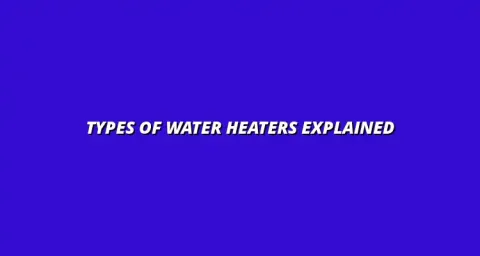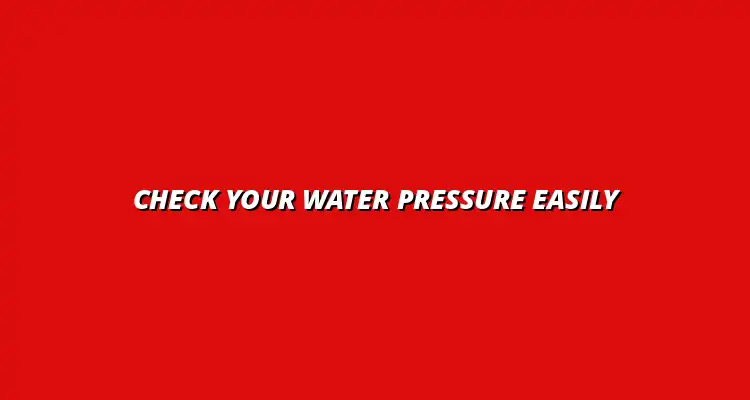
- Plumbing Basics
- Jan 23
2025-02-08
Water pressure is a vital part of any plumbing system. It's the force that moves water through pipes, ensuring it reaches your faucets, showers, and appliances. Without proper water pressure, daily tasks like showering or washing dishes can become frustrating and inefficient!
Understanding water pressure is essential for homeowners because it directly impacts water usage. Low water pressure can lead to slow filling times for baths and sinks, while high water pressure can cause wear and tear on your plumbing system. By learning about water pressure, you can make informed decisions about maintenance and repairs. For a more in-depth understanding of the role of water pressure in your plumbing system, check out this helpful guide on understanding water pressure in plumbing.
Water pressure is defined as the force exerted by water in a plumbing system, typically measured in pounds per square inch (PSI). This pressure is crucial for ensuring that water flows adequately through your pipes and reaches your fixtures. If you've ever experienced a weak trickle from a faucet, you've felt the impact of low water pressure!
Maintaining optimal water pressure is important for several reasons:
Several factors can influence the water pressure in your home, and understanding these can help you diagnose any issues. One factor is the height of your home; generally, the higher the building, the lower the water pressure due to gravity. Another key element is the diameter and condition of your pipes. Hidden leaks can also significantly impact your pressure; learn how to identify and fix leaky pipes to maintain optimal water pressure.
Here are some additional factors to consider:
By being aware of these factors, you can better assess the water pressure in your home and take necessary actions if problems arise.
To manage and maintain your water pressure effectively, knowing how to measure it is crucial. Using the right tools allows you to monitor your plumbing system’s performance regularly. The most common tool for this task is a water pressure gauge, which provides accurate readings of your home's pressure levels.
When selecting a pressure gauge, it’s important to consider several features that suit your needs. Think about the range of pressure it covers, ease of use, and durability. The right gauge will make measuring water pressure straightforward and reliable!
Selecting a pressure gauge can be overwhelming due to the variety available. Your choice should depend on how you plan to use it and the specific plumbing features of your home. Knowing the different types can help you decide which one is best for you!
Here are some considerations when choosing a pressure gauge:
Pressure gauges come in two main types: analog and digital. Each type has its benefits and can suit different preferences. Analog gauges show readings via a dial, while digital gauges provide a numeric display, which some may find easier to read.
When deciding between these types, consider the following:
Ultimately, the choice depends on your personal preference and how comfortable you are with each type!
Finding a quality pressure gauge is key to accurately measuring water pressure. You can purchase them at various locations, including hardware stores, home improvement centers, and online retailers. It's always a good idea to read reviews and check for recommendations before making a purchase! For those experiencing sudden water pressure drops, consider checking the kitchen plumbing as a starting point. You can find useful tips on fixing sudden water pressure drops in your kitchen plumbing.
Here are some popular places to buy pressure gauges:
By carefully selecting where you buy your gauge, you can ensure you get a reliable tool for monitoring your water pressure.
Water pressure issues can be a real headache, but they’re often manageable if you know what to do. Whether you’re dealing with too low or too high pressure, there are solutions available that can help restore balance to your plumbing system. In this section, we'll explore when to seek professional help and what DIY fixes you can try. If you're dealing with low water pressure, there are several easy fixes you can try yourself, starting with checking your faucets. Learn how to fix a leaky faucet and improve your water pressure.
Understanding the symptoms of water pressure problems is the first step to finding a solution. If you notice weak water flow from your taps or hear strange noises in your pipes, it might be time to tackle the issue head-on. For quick solutions to low water pressure issues, consult our easy-to-follow guide on fixing low water pressure.
While some water pressure problems can be fixed at home, others may require the expertise of a professional plumber. Knowing when to call for help can save you time and trouble. For example, if you're in the Birmingham area and need a plumber, check out PlumbProCare's services in Billesley, Birmingham.
Here are some signs that you should contact a plumber:
Before reaching for the phone, consider trying some simple DIY solutions to improve your water pressure. Low water pressure in your water heater? Here's how to troubleshoot: fixing low water pressure in water heaters. These fixes can often solve minor issues without the need for professional help.
Here’s a list of effective DIY tips:
Once you address any existing water pressure problems, it’s crucial to maintain optimal pressure levels. A few proactive steps can go a long way in ensuring your plumbing system operates smoothly.
Regular checks and maintenance practices can help prevent issues from cropping up unexpectedly. By being diligent, you can keep your water pressure where it should be.
Maintaining your plumbing system is essential for ensuring consistent water pressure. Here are some straightforward maintenance tips to follow:
Pressure regulation devices can be a game-changer for maintaining optimal water pressure. They help manage fluctuations and ensure a steady flow throughout your home.
Consider these options for pressure regulation:
Monitoring your water pressure is essential for maintaining a healthy plumbing system and a comfortable home. By understanding the basics of water pressure and how to address issues, you can ensure that your water flow remains consistent.
Regular checks, DIY maintenance, and knowing when to call a professional are all key components of effective water pressure management.
To summarize, here are the key steps for measuring water pressure:
Regularly checking your water pressure can help you catch potential problems early. It’s a simple yet effective way to protect your home and plumbing system.
By staying proactive, you can enjoy a consistent and reliable water supply tailored to your needs. Don’t overlook the importance of water pressure in maintaining a comfortable and functional home!
